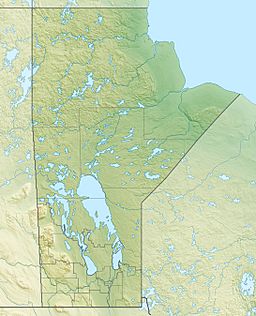Big Island Lake (Manitoba) facts for kids
Quick facts for kids Big Island Lake |
|
|---|---|
| Manistikwan | |

Big Island Lake from the west
|
|
| Location | Manitoba |
| Coordinates | 54°45′N 101°46′W / 54.750°N 101.767°W |
| Lake type | glacial lake |
| Primary inflows | Willow Creek |
| Primary outflows | Big Island Creek |
| Basin countries | Canada |
| Max. length | 9.2 km (5.7 mi) |
| Max. width | 5.2 km (3.2 mi) |
| Surface area | 10 km2 (3.9 sq mi) |
| Max. depth | 46 m (151 ft) |
| Surface elevation | 293 m (961 ft) |
| Islands | +24 |
Big Island Lake is a beautiful glacial lake found about 5 kilometers (3 miles) east of Flin Flon, Manitoba, Canada. It's a popular spot for outdoor fun and a great example of nature's beauty in Canada.
Contents
Exploring Big Island Lake
This lake is long and narrow, running from north to south. You can easily get to it by Manitoba Highway 10. Many people have summer homes, called cottages, around the lake. You'll find them on the south end, on the large island, and in other spots around the lake.
Lake Connections and Surroundings
Big Island Lake flows into Schist Lake through a stream called Big Island Creek. This creek is part of the larger Nelson River system, which eventually flows into Hudson Bay.
The area around the lake is covered by a special type of forest called a boreal forest. This forest is part of the Canadian Shield, which is a very old and rocky part of North America. The trees here are a mix of evergreens and trees that lose their leaves in the fall.
Wildlife and Fishing Adventures
Big Island Lake is a favorite place for people who love nature and wildlife. You might spot large animals like moose, black bears, white-tailed deer, and even woodland caribou. Many different kinds of water birds also live here.
If you enjoy fishing, you're in luck! The lake is home to several types of fish, including northern pike, walleye, burbot, whitefish, and lake trout.
What's in a Name?
Big Island Lake gets its name from the very large island that stands out in the middle of the lake. This name became official in 1999. Before that, people sometimes used the traditional Cree name "Manistikwan" for this lake. "Manistikwan" means "Devil's Head" and was originally the name for nearby Schist Lake.



